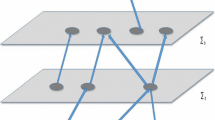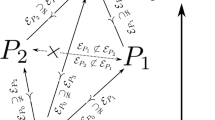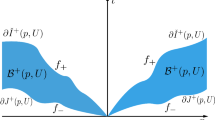Abstract
We give an analysis over a variation of causal sets where the light cone of an event is represented by finitely branching trees with respect to any given arbitrary dynamics. We argue through basic topological properties of Cantor space that under certain assumptions about the universe, spacetime structure and causation, given any event x, the number of all possible future worldlines of x within the many-worlds interpretation is uncountable. However, if all worldlines extending the event x are ‘eventually deterministic’, then the cardinality of the set of future worldlines with respect to x is exactly \(\aleph _0\), i.e., countably infinite. We also observe that if there are countably many future worldlines with respect to x, then at least one of them must be necessarily ‘decidable’ in the sense that there is an algorithm which determines whether or not any given event belongs to that worldline. We then show that if there are only finitely many worldlines in the future of an event x, then they are all decidable. We finally point out the fact that there can be only countably many terminating worldlines.



Similar content being viewed by others
Notes
For details, see the discussion after Corollary 2.
Without (iii) we get a pre-order. In fact, (iii) avoids cycles, that is, closed time-like curves, and as pointed out in [38], ‘events on a causal loop would therefore not be distinct at all and the theory lacks the resources the distinguish between a single event and a causal loop’ (p. 11).
This condition is usually omitted, but it is stated in [38].
We shall call this Malament’s theorem for future reference.
For details, we refer the reader to [19], particularly p. 20.
See [3] for a revised version of branching space-time.
The word ‘effective’ means ‘computable’. Secondly, we will in fact use the space \(n^\mathbb {N}\) for arbitrary \(n\in \mathbb {N}\), which we shall refer to it with the same name since \(2^\mathbb {N}\) and \(n^\mathbb {N}\) are topologically the same.
We will define what we mean by eventually deterministic in Sect. 2.2.
Whether the universe has a beginning or not will not be relevant to our analysis and will not affect the results for reasons that will become clear later. However, since we will be concerned with spacetime light cones of events in its general form—particularly the future light cone of events—we may assume without loss of generality that the past and future cones are both unbounded and so we will make our analysis under the assumption that the future light cone of any event is potentially unbounded. Eternal past can be assumed in an oscillating universe model. Nevertheless, we will be primarily concerned with the future light cone of events only.
In fact, whether spacetime is discrete or continuous is not a settled question in physics as both are consistent with different physical theories. See [17] for a discussion.
By event we mean an instantaneous situation or action that is associated with a point in spacetime. Events are primitive objects of the domain of discourse in any theory of causal sets.
Chronologically speaking, these are called future and past distinguishing spacetimes for which Malament’s theorem proves the equality of the existence of a chronological bijection and the existence of conformal isometry. Levichev (1987) [23] then showed that a causal bijection implies a chronological bijection and hence Malament’s theorem can be generalized to causal bijections.
This is also known as the locally finiteness condition in causal sets.
In most theories of causal sets, the anti-symmetric property is implicitly assumed. We follow the same tradition.
We may use the terms computable and decidable interchangably depending on the context.
Note that the concatenation operation is not commutative.
For further discussion on how we define a tree for a light cone of an event, see Elaboration of III(a) in Sect. 2.3.
See the discussion at the end of Sect. 2.2 for more details.
This discussion can possibly be extended to show that under Lorentz transformation, there exist a suitable pairing function that can translate the order of events/branches between different reference frames while maintaining the overall causal structure of forward and backward branching trees, however, we did not delve further into this line of inquiry.
In [21], it was shown that as time tick t increases, the number of possibilites grows exponentially. In [1], it was shown that every causal set dynamics typically yields an exponentially expanding universe. The way we define our tree and how it grows explonentially is compatible with this observation.
References
Ahmed, M., Rideout, D.: Indications of de Sitter spacetime from classical sequential growth dynamics of causal sets. Phys. Rev. D 81(8), 083528 (2010)
Belnap, N.: Branching space-time. Synthese 92(3), 385–434 (1992)
Belnap, N., Müller, T., Placek, T.: New foundations for branching space-times. Studia Logica 109(2), 239–284 (2021)
Bolognesi, T.: Algorithmic causets. J. Phys. Conf. Ser. 306, 012042 (2011)
Bombelli, L.: Space-time as a causal set, PhD Thesis, Syracuse University (1987)
Bombelli, L., Henson, J., Sorkin, R.D.: Discreteness without symmetry breaking: a theorem. Mod. Phys. Lett. A24, 2579–2587 (2009)
Bombelli, L., Lee, J., Meyer, D., Sorkin, R.D.: Space-time as a causal set. Phys. Rev. Lett. 59(5), 521–524 (1987)
Cantor, G.: Ueber die Ausdehnung eines Satzes aus der Theorie der trigonometrischen Reihen. Mathematische Annalen 5(1), 123–132 (1872)
Cenzer, D.: Classes in recursion theory. In: Handbook of Computability Theory, pp. 37–39. North-Holland, Amsterdam (1999)
Deutsch, D.: The Fabric Of Reality: Towards a Theory of Everything. Lane, London (1997)
Diamondstone, D.E., Dzhafarov, D.D., Soare, R.I.: \(\Pi ^0_1\) classes, peano arithmetic, randomness, and computable domination, Notre Dame. J. Formal Logic 51, 127–159 (2010)
Dowker, F.: Causal sets as discrete spacetime. Contemp. Phys. 47(1), 1–9 (2006)
Dowker, F., Zalel, S.: Evolution of universes in causal set cosmology. Comptes Rendus Phys. 18(3–4), 246–253 (2017)
Dribus, B.F.: Discrete Causal Theory Emergent Spacetime and the Causal Metric Hypothesis. Springer, Berlin (2018)
Earman, J.: Pruning some branches from “Branching spacetimes". Philos. Found. Phys. 4, 187–205 (2008)
Everett, H.: Relative state formulation of quantum mechanics. Rev. Mod. Phys. 29(3), 454–462 (1957)
Forrest, P.: Is space-time discrete or continuous? An empirical question. Synthese 103(3), 327–354 (1995)
Healey, R.A.: How many worlds? Nous 4, 591–616 (1984)
Hu, Y.: The Causal Set Approach to Quantum Gravity, PhD Thesis, Imperial College London (2013)
Kempf, A.: Spacetime could be simultaneously continuous and discrete, in the same way that information can be. New J. Phys. 12(11), 115001 (2010)
Kleitman, D.J., Rothschild, B.L.: Asymptotic enumeration of partial orders on a finite set. Trans. Am. Math. Soc. 205, 205–220 (1975)
König, D.: Sur les correspondances multivoques des ensembles. Fund. Math. 8(1), 114–134 (1926)
Levichev, A.V.: Prescribing the conformal geometry of a Lorentz manifold by means of its causal structure. Sov. Math. Dokl. 35, 452–455 (1987)
Linde, A., Vanchurin, V.: How many universes are in the multiverse? Phys. Rev. D 81(8), 083525 (2010)
Malament, D.: The class of continuous timelike curves determines the topology of space-time. J. Math. Phys. 18, 1399–1404 (1977)
Masanes, L., Acin, A., Gisin, N.: General properties of nonsignaling theories. Phys. Rev. A 73(1), 012112 (2006)
Meyer, D.A.: The dimension of causal sets, PhD Thesis, Massachusetts Institute of Technology (1988)
Müller, T.: A generalized manifold topology for branching space-times. Philos. Sci. 80(5), 1089–1100 (2013)
Nies, A.: Computability and Randomness. Oxford University Press, Oxford (2019)
Norsen, T., Nelson, S.: Yet Another Snapshot of Foundational Attitudes Toward Quantum Mechanics (2013) arXiv: 1306.4646
Reid, D.D.: Discrete quantum gravity and causal sets. Can. J. Phys. 79(1), 1–16 (2001)
Rideout, D.P., Sorkin, R.D.: A classical sequential growth dynamics for causal sets. Phys. Rev. D 61(2), 024002 (1999)
Schlosshauer, M., Kofler, J., Zeilinger, A.: A snapshot of foundational attitudes toward quantum mechanics. Stud. Hist. Philos. Sci. Part B 44(3), 222–230 (2013)
Sorkin, R.D., Gomberoff, A.: Causal sets: discrete gravity. In: Donald, M. (ed.) Lectures on Quantum Gravity, pp. 305–327. Springer, Berlin (2005)
Surya, S.: The causal set approach to quantum gravity. Living Rev. Relativ. 22, 5 (2019)
Vanchurin, V.: The continuum of discrete trajectories in eternal inflation. Phys. Rev. D 91(2), 023511 (2014)
Wallden, P.: Causal sets dynamics: review & outlook. J. Phys.: Conf. Ser. 453, 012023 (2013)
Wütrich, C., Huggett, N.: Out of Nowhere: The emergence of spacetime from causal sets (2020) arXiv: 2009.02951
Yamamoto, H.: Discrete spacetime and Lorentz invariance. Nucl. Phys. B 6, 154–156 (1989)
Acknowledgements
We would like to thank the anonymous referee for many useful suggestions which significantly improved the quality of this work. We would also like to thank David D. Reid, and Özlem Salehi for their valuable feedback and comments.
Author information
Authors and Affiliations
Corresponding author
Additional information
Publisher's Note
Springer Nature remains neutral with regard to jurisdictional claims in published maps and institutional affiliations.
Rights and permissions
Springer Nature or its licensor (e.g. a society or other partner) holds exclusive rights to this article under a publishing agreement with the author(s) or other rightsholder(s); author self-archiving of the accepted manuscript version of this article is solely governed by the terms of such publishing agreement and applicable law.
About this article
Cite this article
Çevik, A., Seskir, Z. On the Cardinality of Future Worldlines in Discrete Spacetime Structures. Found Phys 53, 61 (2023). https://doi.org/10.1007/s10701-023-00701-1
Received:
Accepted:
Published:
DOI: https://doi.org/10.1007/s10701-023-00701-1




